Menu Development: Customer, Business Needs and Profit Maximization
VerifiedAdded on 2023/06/13
|13
|3401
|204
Report
AI Summary
This report delves into the principles of menu planning and design, emphasizing the crucial balance between meeting customer expectations and achieving business profitability. It examines various menu types, including Table d'hôte, A la carte, Du Jour, Cycle, and Static menus, highlighting how customer preferences, dietary needs, and legal requirements influence menu design. The report also discusses menu engineering as a strategy to maximize profitability by analyzing demand and margin contribution. Furthermore, it presents a realistic plan for developing a menu that aligns with both customer demands and business objectives, incorporating market research, course selection, pricing strategies, layout design, staff training, and adherence to health and safety regulations. The chosen company for analysis is Gordon Ramsay, used as an example of how an established restaurant navigates menu development to compete effectively in the market and satisfy customer needs while maximizing profits.
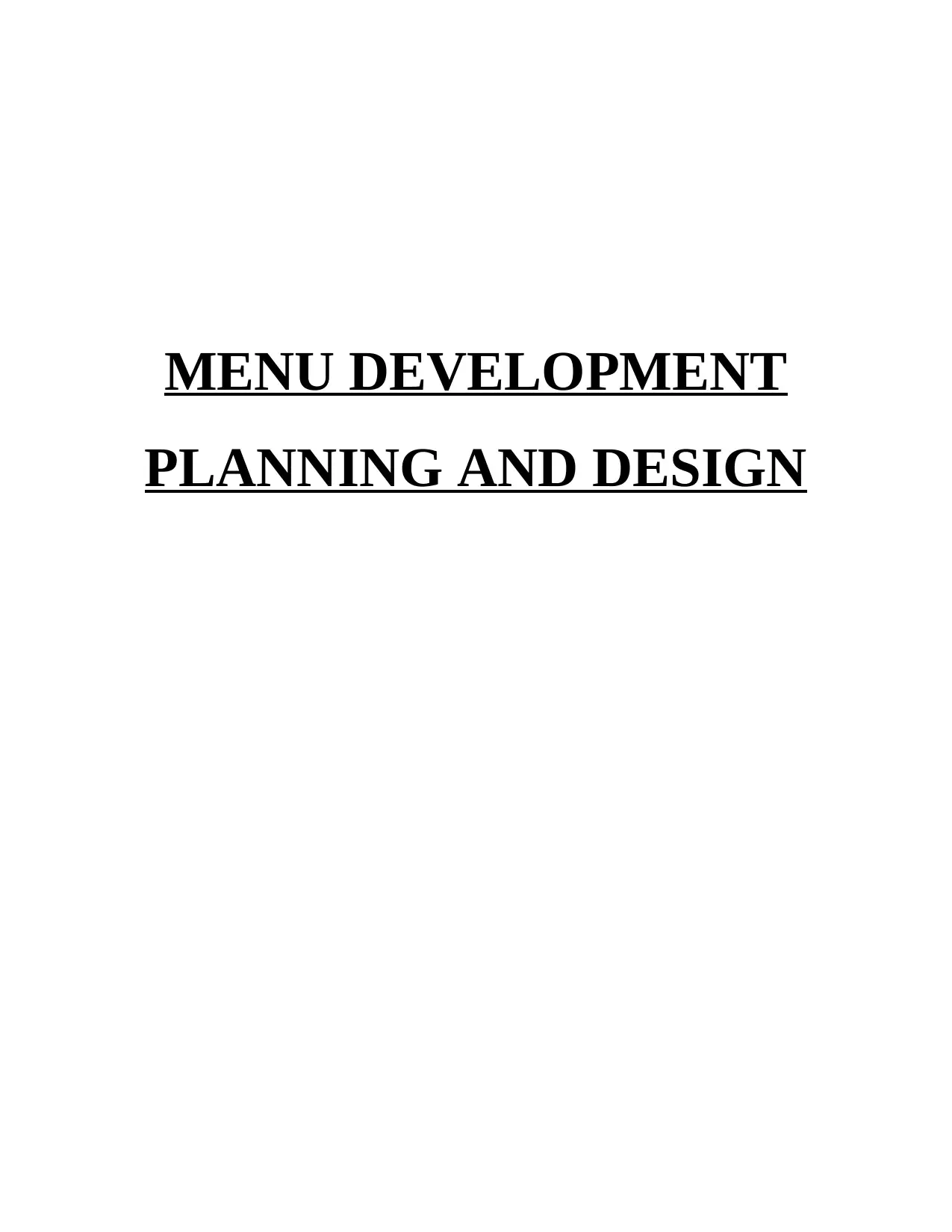
MENU DEVELOPMENT
PLANNING AND DESIGN
PLANNING AND DESIGN
Paraphrase This Document
Need a fresh take? Get an instant paraphrase of this document with our AI Paraphraser
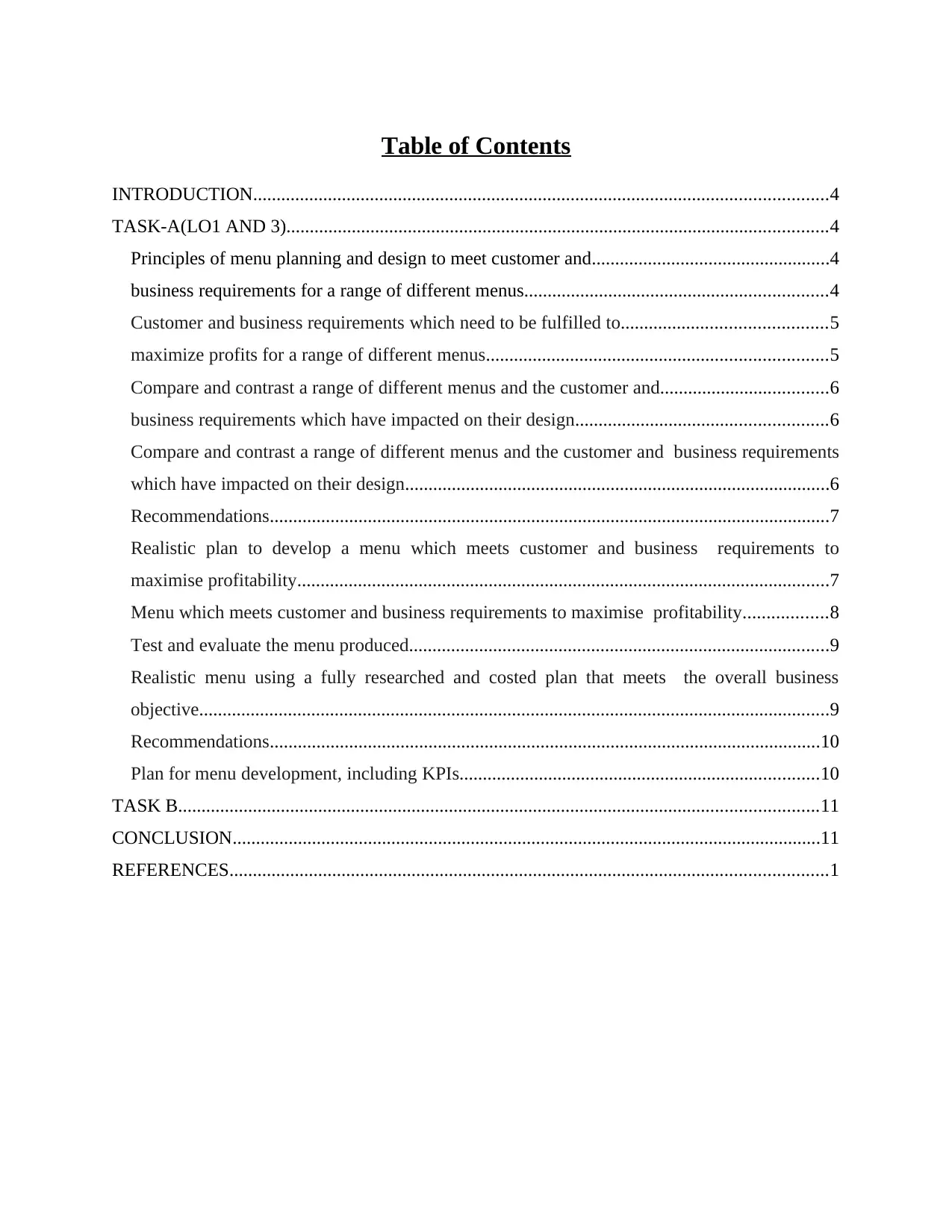
Table of Contents
INTRODUCTION...........................................................................................................................4
TASK-A(LO1 AND 3)....................................................................................................................4
Principles of menu planning and design to meet customer and...................................................4
business requirements for a range of different menus.................................................................4
Customer and business requirements which need to be fulfilled to............................................5
maximize profits for a range of different menus.........................................................................5
Compare and contrast a range of different menus and the customer and....................................6
business requirements which have impacted on their design......................................................6
Compare and contrast a range of different menus and the customer and business requirements
which have impacted on their design...........................................................................................6
Recommendations........................................................................................................................7
Realistic plan to develop a menu which meets customer and business requirements to
maximise profitability..................................................................................................................7
Menu which meets customer and business requirements to maximise profitability..................8
Test and evaluate the menu produced..........................................................................................9
Realistic menu using a fully researched and costed plan that meets the overall business
objective.......................................................................................................................................9
Recommendations......................................................................................................................10
Plan for menu development, including KPIs.............................................................................10
TASK B.........................................................................................................................................11
CONCLUSION..............................................................................................................................11
REFERENCES................................................................................................................................1
INTRODUCTION...........................................................................................................................4
TASK-A(LO1 AND 3)....................................................................................................................4
Principles of menu planning and design to meet customer and...................................................4
business requirements for a range of different menus.................................................................4
Customer and business requirements which need to be fulfilled to............................................5
maximize profits for a range of different menus.........................................................................5
Compare and contrast a range of different menus and the customer and....................................6
business requirements which have impacted on their design......................................................6
Compare and contrast a range of different menus and the customer and business requirements
which have impacted on their design...........................................................................................6
Recommendations........................................................................................................................7
Realistic plan to develop a menu which meets customer and business requirements to
maximise profitability..................................................................................................................7
Menu which meets customer and business requirements to maximise profitability..................8
Test and evaluate the menu produced..........................................................................................9
Realistic menu using a fully researched and costed plan that meets the overall business
objective.......................................................................................................................................9
Recommendations......................................................................................................................10
Plan for menu development, including KPIs.............................................................................10
TASK B.........................................................................................................................................11
CONCLUSION..............................................................................................................................11
REFERENCES................................................................................................................................1

⊘ This is a preview!⊘
Do you want full access?
Subscribe today to unlock all pages.

Trusted by 1+ million students worldwide
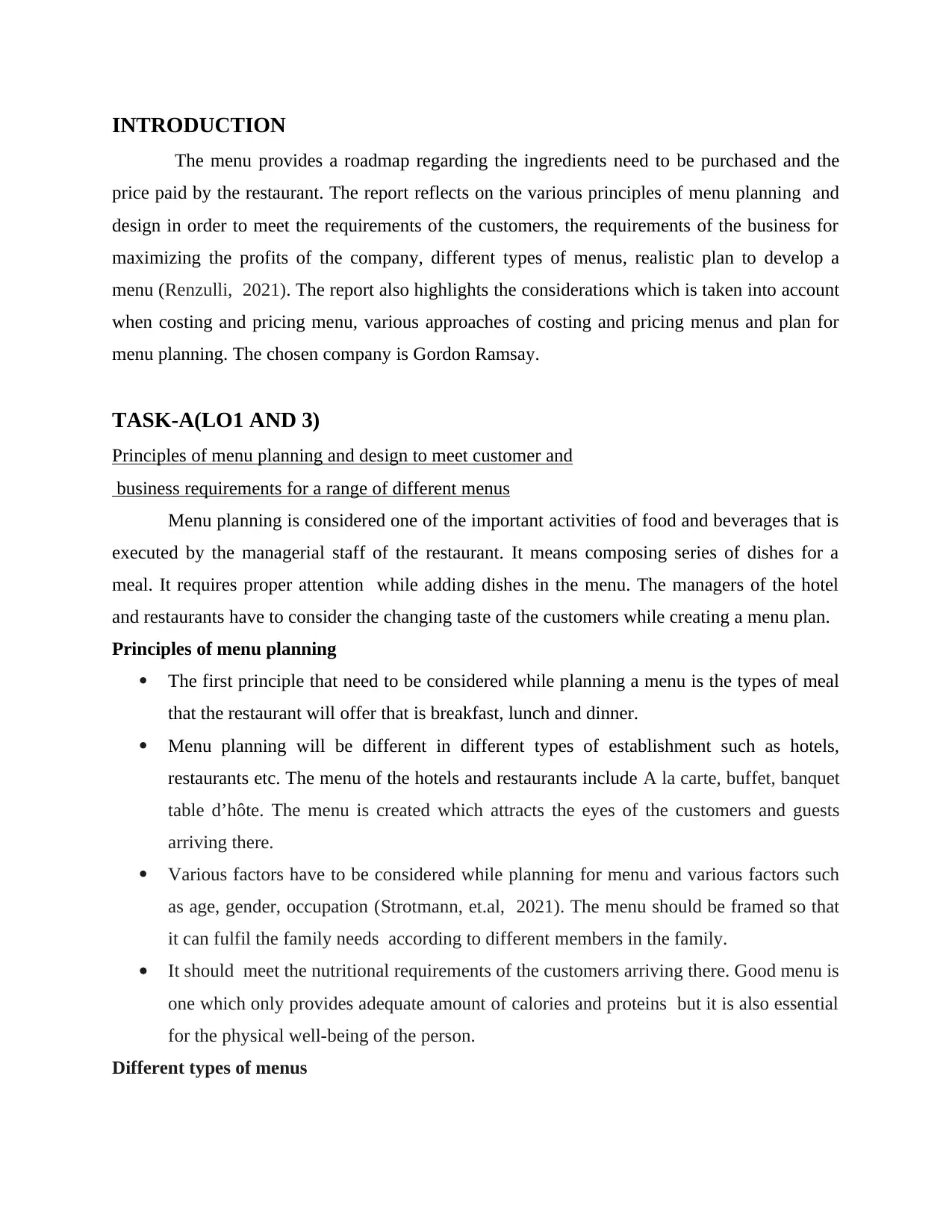
INTRODUCTION
The menu provides a roadmap regarding the ingredients need to be purchased and the
price paid by the restaurant. The report reflects on the various principles of menu planning and
design in order to meet the requirements of the customers, the requirements of the business for
maximizing the profits of the company, different types of menus, realistic plan to develop a
menu (Renzulli, 2021). The report also highlights the considerations which is taken into account
when costing and pricing menu, various approaches of costing and pricing menus and plan for
menu planning. The chosen company is Gordon Ramsay.
TASK-A(LO1 AND 3)
Principles of menu planning and design to meet customer and
business requirements for a range of different menus
Menu planning is considered one of the important activities of food and beverages that is
executed by the managerial staff of the restaurant. It means composing series of dishes for a
meal. It requires proper attention while adding dishes in the menu. The managers of the hotel
and restaurants have to consider the changing taste of the customers while creating a menu plan.
Principles of menu planning
The first principle that need to be considered while planning a menu is the types of meal
that the restaurant will offer that is breakfast, lunch and dinner.
Menu planning will be different in different types of establishment such as hotels,
restaurants etc. The menu of the hotels and restaurants include A la carte, buffet, banquet
table d’hôte. The menu is created which attracts the eyes of the customers and guests
arriving there.
Various factors have to be considered while planning for menu and various factors such
as age, gender, occupation (Strotmann, et.al, 2021). The menu should be framed so that
it can fulfil the family needs according to different members in the family.
It should meet the nutritional requirements of the customers arriving there. Good menu is
one which only provides adequate amount of calories and proteins but it is also essential
for the physical well-being of the person.
Different types of menus
The menu provides a roadmap regarding the ingredients need to be purchased and the
price paid by the restaurant. The report reflects on the various principles of menu planning and
design in order to meet the requirements of the customers, the requirements of the business for
maximizing the profits of the company, different types of menus, realistic plan to develop a
menu (Renzulli, 2021). The report also highlights the considerations which is taken into account
when costing and pricing menu, various approaches of costing and pricing menus and plan for
menu planning. The chosen company is Gordon Ramsay.
TASK-A(LO1 AND 3)
Principles of menu planning and design to meet customer and
business requirements for a range of different menus
Menu planning is considered one of the important activities of food and beverages that is
executed by the managerial staff of the restaurant. It means composing series of dishes for a
meal. It requires proper attention while adding dishes in the menu. The managers of the hotel
and restaurants have to consider the changing taste of the customers while creating a menu plan.
Principles of menu planning
The first principle that need to be considered while planning a menu is the types of meal
that the restaurant will offer that is breakfast, lunch and dinner.
Menu planning will be different in different types of establishment such as hotels,
restaurants etc. The menu of the hotels and restaurants include A la carte, buffet, banquet
table d’hôte. The menu is created which attracts the eyes of the customers and guests
arriving there.
Various factors have to be considered while planning for menu and various factors such
as age, gender, occupation (Strotmann, et.al, 2021). The menu should be framed so that
it can fulfil the family needs according to different members in the family.
It should meet the nutritional requirements of the customers arriving there. Good menu is
one which only provides adequate amount of calories and proteins but it is also essential
for the physical well-being of the person.
Different types of menus
Paraphrase This Document
Need a fresh take? Get an instant paraphrase of this document with our AI Paraphraser
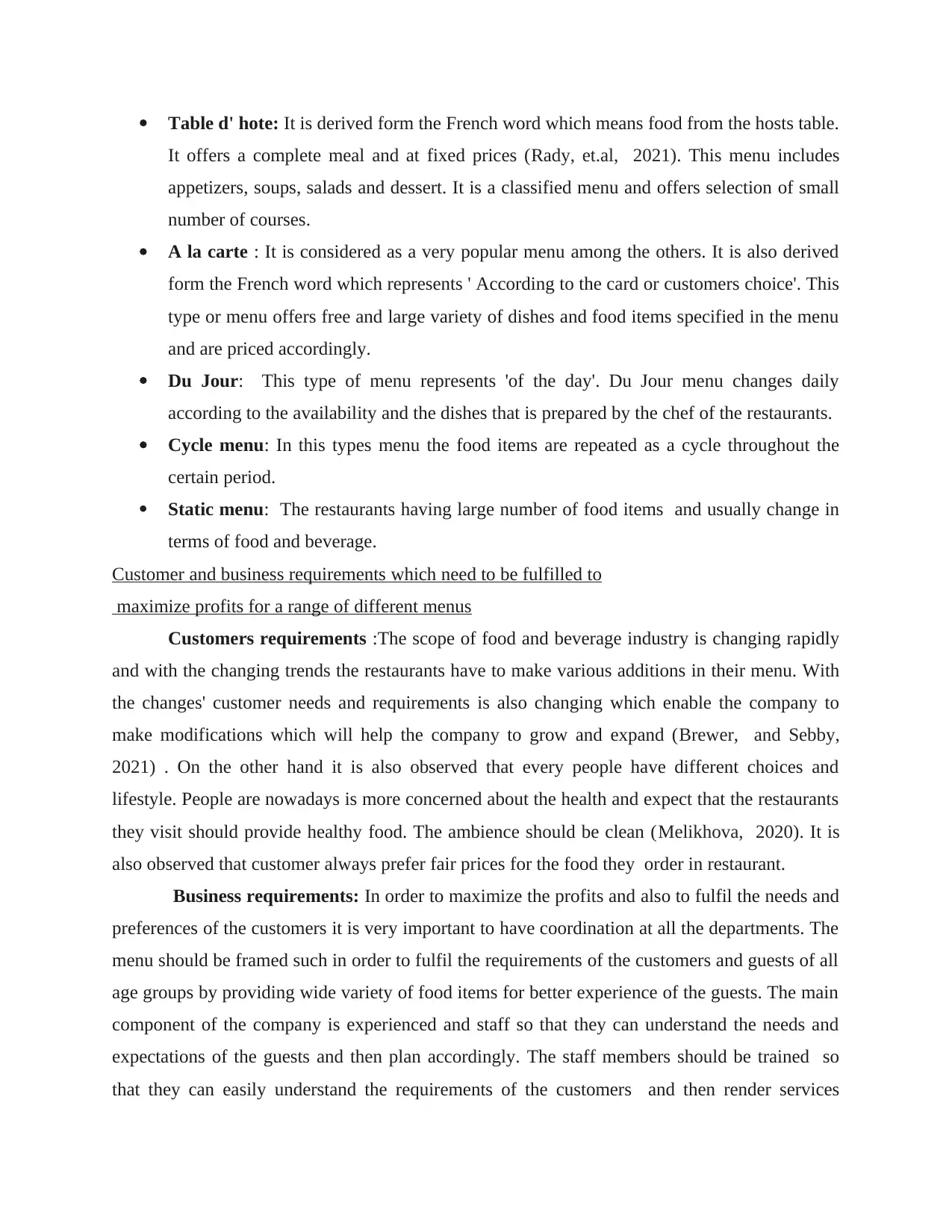
Table d' hote: It is derived form the French word which means food from the hosts table.
It offers a complete meal and at fixed prices (Rady, et.al, 2021). This menu includes
appetizers, soups, salads and dessert. It is a classified menu and offers selection of small
number of courses.
A la carte : It is considered as a very popular menu among the others. It is also derived
form the French word which represents ' According to the card or customers choice'. This
type or menu offers free and large variety of dishes and food items specified in the menu
and are priced accordingly.
Du Jour: This type of menu represents 'of the day'. Du Jour menu changes daily
according to the availability and the dishes that is prepared by the chef of the restaurants.
Cycle menu: In this types menu the food items are repeated as a cycle throughout the
certain period.
Static menu: The restaurants having large number of food items and usually change in
terms of food and beverage.
Customer and business requirements which need to be fulfilled to
maximize profits for a range of different menus
Customers requirements :The scope of food and beverage industry is changing rapidly
and with the changing trends the restaurants have to make various additions in their menu. With
the changes' customer needs and requirements is also changing which enable the company to
make modifications which will help the company to grow and expand (Brewer, and Sebby,
2021) . On the other hand it is also observed that every people have different choices and
lifestyle. People are nowadays is more concerned about the health and expect that the restaurants
they visit should provide healthy food. The ambience should be clean (Melikhova, 2020). It is
also observed that customer always prefer fair prices for the food they order in restaurant.
Business requirements: In order to maximize the profits and also to fulfil the needs and
preferences of the customers it is very important to have coordination at all the departments. The
menu should be framed such in order to fulfil the requirements of the customers and guests of all
age groups by providing wide variety of food items for better experience of the guests. The main
component of the company is experienced and staff so that they can understand the needs and
expectations of the guests and then plan accordingly. The staff members should be trained so
that they can easily understand the requirements of the customers and then render services
It offers a complete meal and at fixed prices (Rady, et.al, 2021). This menu includes
appetizers, soups, salads and dessert. It is a classified menu and offers selection of small
number of courses.
A la carte : It is considered as a very popular menu among the others. It is also derived
form the French word which represents ' According to the card or customers choice'. This
type or menu offers free and large variety of dishes and food items specified in the menu
and are priced accordingly.
Du Jour: This type of menu represents 'of the day'. Du Jour menu changes daily
according to the availability and the dishes that is prepared by the chef of the restaurants.
Cycle menu: In this types menu the food items are repeated as a cycle throughout the
certain period.
Static menu: The restaurants having large number of food items and usually change in
terms of food and beverage.
Customer and business requirements which need to be fulfilled to
maximize profits for a range of different menus
Customers requirements :The scope of food and beverage industry is changing rapidly
and with the changing trends the restaurants have to make various additions in their menu. With
the changes' customer needs and requirements is also changing which enable the company to
make modifications which will help the company to grow and expand (Brewer, and Sebby,
2021) . On the other hand it is also observed that every people have different choices and
lifestyle. People are nowadays is more concerned about the health and expect that the restaurants
they visit should provide healthy food. The ambience should be clean (Melikhova, 2020). It is
also observed that customer always prefer fair prices for the food they order in restaurant.
Business requirements: In order to maximize the profits and also to fulfil the needs and
preferences of the customers it is very important to have coordination at all the departments. The
menu should be framed such in order to fulfil the requirements of the customers and guests of all
age groups by providing wide variety of food items for better experience of the guests. The main
component of the company is experienced and staff so that they can understand the needs and
expectations of the guests and then plan accordingly. The staff members should be trained so
that they can easily understand the requirements of the customers and then render services
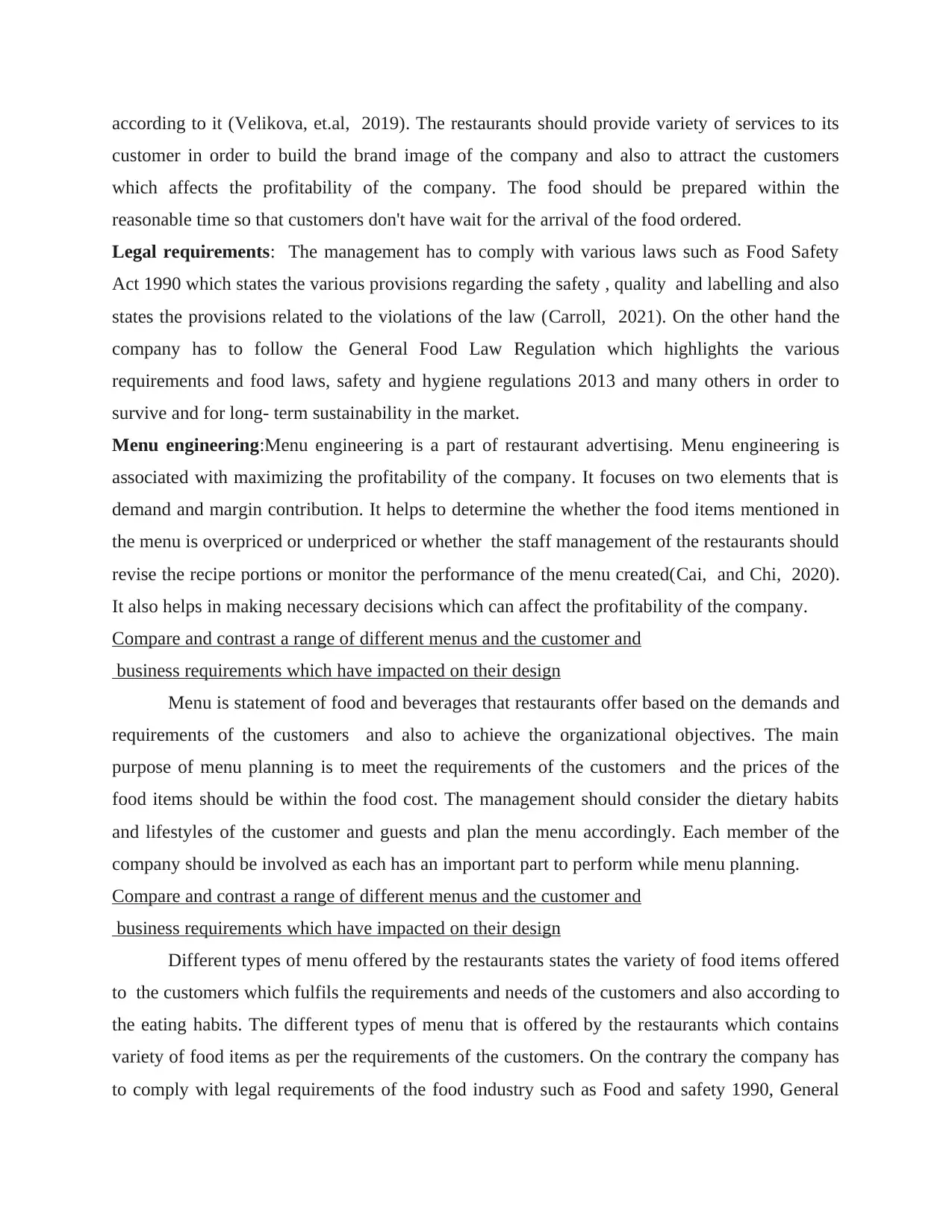
according to it (Velikova, et.al, 2019). The restaurants should provide variety of services to its
customer in order to build the brand image of the company and also to attract the customers
which affects the profitability of the company. The food should be prepared within the
reasonable time so that customers don't have wait for the arrival of the food ordered.
Legal requirements: The management has to comply with various laws such as Food Safety
Act 1990 which states the various provisions regarding the safety , quality and labelling and also
states the provisions related to the violations of the law (Carroll, 2021). On the other hand the
company has to follow the General Food Law Regulation which highlights the various
requirements and food laws, safety and hygiene regulations 2013 and many others in order to
survive and for long- term sustainability in the market.
Menu engineering:Menu engineering is a part of restaurant advertising. Menu engineering is
associated with maximizing the profitability of the company. It focuses on two elements that is
demand and margin contribution. It helps to determine the whether the food items mentioned in
the menu is overpriced or underpriced or whether the staff management of the restaurants should
revise the recipe portions or monitor the performance of the menu created(Cai, and Chi, 2020).
It also helps in making necessary decisions which can affect the profitability of the company.
Compare and contrast a range of different menus and the customer and
business requirements which have impacted on their design
Menu is statement of food and beverages that restaurants offer based on the demands and
requirements of the customers and also to achieve the organizational objectives. The main
purpose of menu planning is to meet the requirements of the customers and the prices of the
food items should be within the food cost. The management should consider the dietary habits
and lifestyles of the customer and guests and plan the menu accordingly. Each member of the
company should be involved as each has an important part to perform while menu planning.
Compare and contrast a range of different menus and the customer and
business requirements which have impacted on their design
Different types of menu offered by the restaurants states the variety of food items offered
to the customers which fulfils the requirements and needs of the customers and also according to
the eating habits. The different types of menu that is offered by the restaurants which contains
variety of food items as per the requirements of the customers. On the contrary the company has
to comply with legal requirements of the food industry such as Food and safety 1990, General
customer in order to build the brand image of the company and also to attract the customers
which affects the profitability of the company. The food should be prepared within the
reasonable time so that customers don't have wait for the arrival of the food ordered.
Legal requirements: The management has to comply with various laws such as Food Safety
Act 1990 which states the various provisions regarding the safety , quality and labelling and also
states the provisions related to the violations of the law (Carroll, 2021). On the other hand the
company has to follow the General Food Law Regulation which highlights the various
requirements and food laws, safety and hygiene regulations 2013 and many others in order to
survive and for long- term sustainability in the market.
Menu engineering:Menu engineering is a part of restaurant advertising. Menu engineering is
associated with maximizing the profitability of the company. It focuses on two elements that is
demand and margin contribution. It helps to determine the whether the food items mentioned in
the menu is overpriced or underpriced or whether the staff management of the restaurants should
revise the recipe portions or monitor the performance of the menu created(Cai, and Chi, 2020).
It also helps in making necessary decisions which can affect the profitability of the company.
Compare and contrast a range of different menus and the customer and
business requirements which have impacted on their design
Menu is statement of food and beverages that restaurants offer based on the demands and
requirements of the customers and also to achieve the organizational objectives. The main
purpose of menu planning is to meet the requirements of the customers and the prices of the
food items should be within the food cost. The management should consider the dietary habits
and lifestyles of the customer and guests and plan the menu accordingly. Each member of the
company should be involved as each has an important part to perform while menu planning.
Compare and contrast a range of different menus and the customer and
business requirements which have impacted on their design
Different types of menu offered by the restaurants states the variety of food items offered
to the customers which fulfils the requirements and needs of the customers and also according to
the eating habits. The different types of menu that is offered by the restaurants which contains
variety of food items as per the requirements of the customers. On the contrary the company has
to comply with legal requirements of the food industry such as Food and safety 1990, General
⊘ This is a preview!⊘
Do you want full access?
Subscribe today to unlock all pages.

Trusted by 1+ million students worldwide
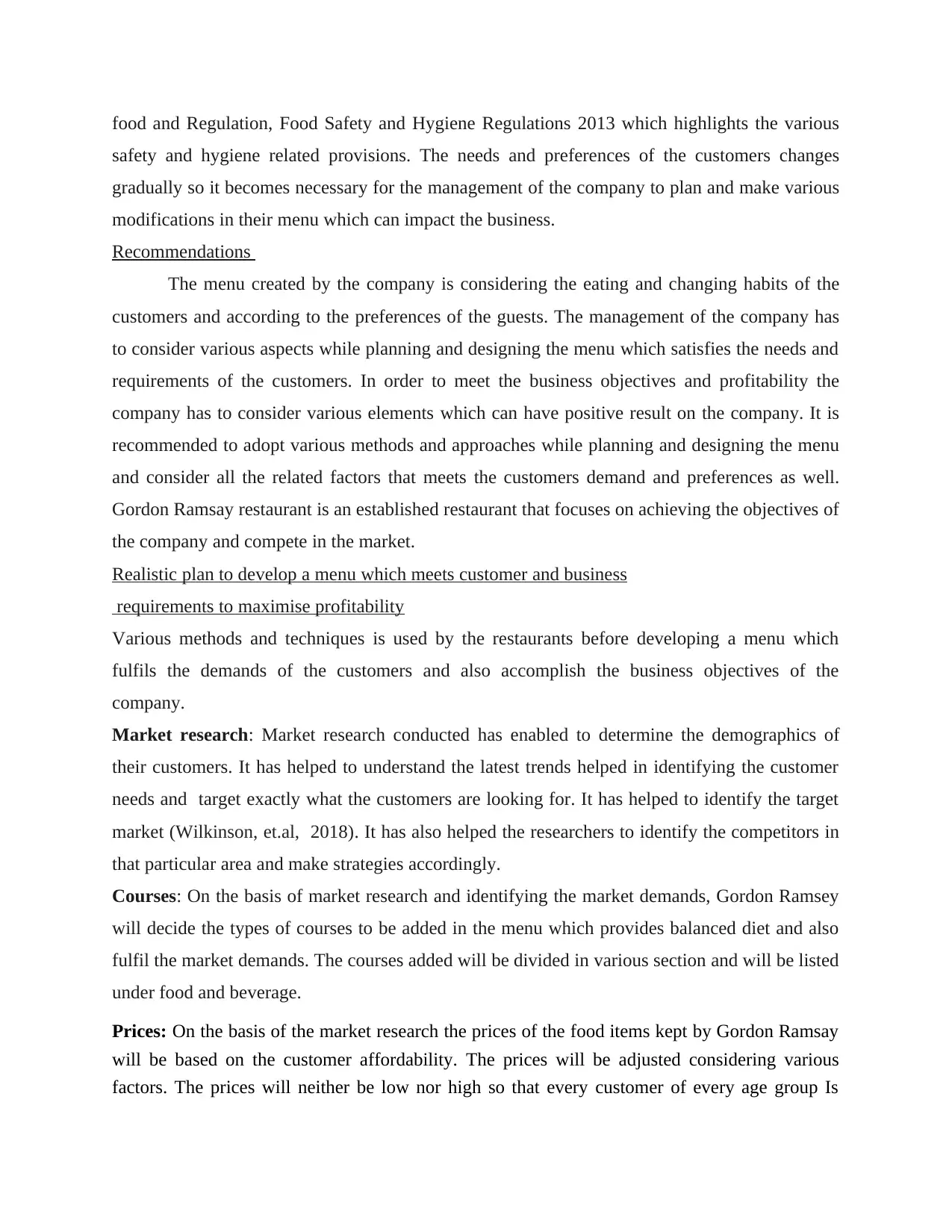
food and Regulation, Food Safety and Hygiene Regulations 2013 which highlights the various
safety and hygiene related provisions. The needs and preferences of the customers changes
gradually so it becomes necessary for the management of the company to plan and make various
modifications in their menu which can impact the business.
Recommendations
The menu created by the company is considering the eating and changing habits of the
customers and according to the preferences of the guests. The management of the company has
to consider various aspects while planning and designing the menu which satisfies the needs and
requirements of the customers. In order to meet the business objectives and profitability the
company has to consider various elements which can have positive result on the company. It is
recommended to adopt various methods and approaches while planning and designing the menu
and consider all the related factors that meets the customers demand and preferences as well.
Gordon Ramsay restaurant is an established restaurant that focuses on achieving the objectives of
the company and compete in the market.
Realistic plan to develop a menu which meets customer and business
requirements to maximise profitability
Various methods and techniques is used by the restaurants before developing a menu which
fulfils the demands of the customers and also accomplish the business objectives of the
company.
Market research: Market research conducted has enabled to determine the demographics of
their customers. It has helped to understand the latest trends helped in identifying the customer
needs and target exactly what the customers are looking for. It has helped to identify the target
market (Wilkinson, et.al, 2018). It has also helped the researchers to identify the competitors in
that particular area and make strategies accordingly.
Courses: On the basis of market research and identifying the market demands, Gordon Ramsey
will decide the types of courses to be added in the menu which provides balanced diet and also
fulfil the market demands. The courses added will be divided in various section and will be listed
under food and beverage.
Prices: On the basis of the market research the prices of the food items kept by Gordon Ramsay
will be based on the customer affordability. The prices will be adjusted considering various
factors. The prices will neither be low nor high so that every customer of every age group Is
safety and hygiene related provisions. The needs and preferences of the customers changes
gradually so it becomes necessary for the management of the company to plan and make various
modifications in their menu which can impact the business.
Recommendations
The menu created by the company is considering the eating and changing habits of the
customers and according to the preferences of the guests. The management of the company has
to consider various aspects while planning and designing the menu which satisfies the needs and
requirements of the customers. In order to meet the business objectives and profitability the
company has to consider various elements which can have positive result on the company. It is
recommended to adopt various methods and approaches while planning and designing the menu
and consider all the related factors that meets the customers demand and preferences as well.
Gordon Ramsay restaurant is an established restaurant that focuses on achieving the objectives of
the company and compete in the market.
Realistic plan to develop a menu which meets customer and business
requirements to maximise profitability
Various methods and techniques is used by the restaurants before developing a menu which
fulfils the demands of the customers and also accomplish the business objectives of the
company.
Market research: Market research conducted has enabled to determine the demographics of
their customers. It has helped to understand the latest trends helped in identifying the customer
needs and target exactly what the customers are looking for. It has helped to identify the target
market (Wilkinson, et.al, 2018). It has also helped the researchers to identify the competitors in
that particular area and make strategies accordingly.
Courses: On the basis of market research and identifying the market demands, Gordon Ramsey
will decide the types of courses to be added in the menu which provides balanced diet and also
fulfil the market demands. The courses added will be divided in various section and will be listed
under food and beverage.
Prices: On the basis of the market research the prices of the food items kept by Gordon Ramsay
will be based on the customer affordability. The prices will be adjusted considering various
factors. The prices will neither be low nor high so that every customer of every age group Is
Paraphrase This Document
Need a fresh take? Get an instant paraphrase of this document with our AI Paraphraser
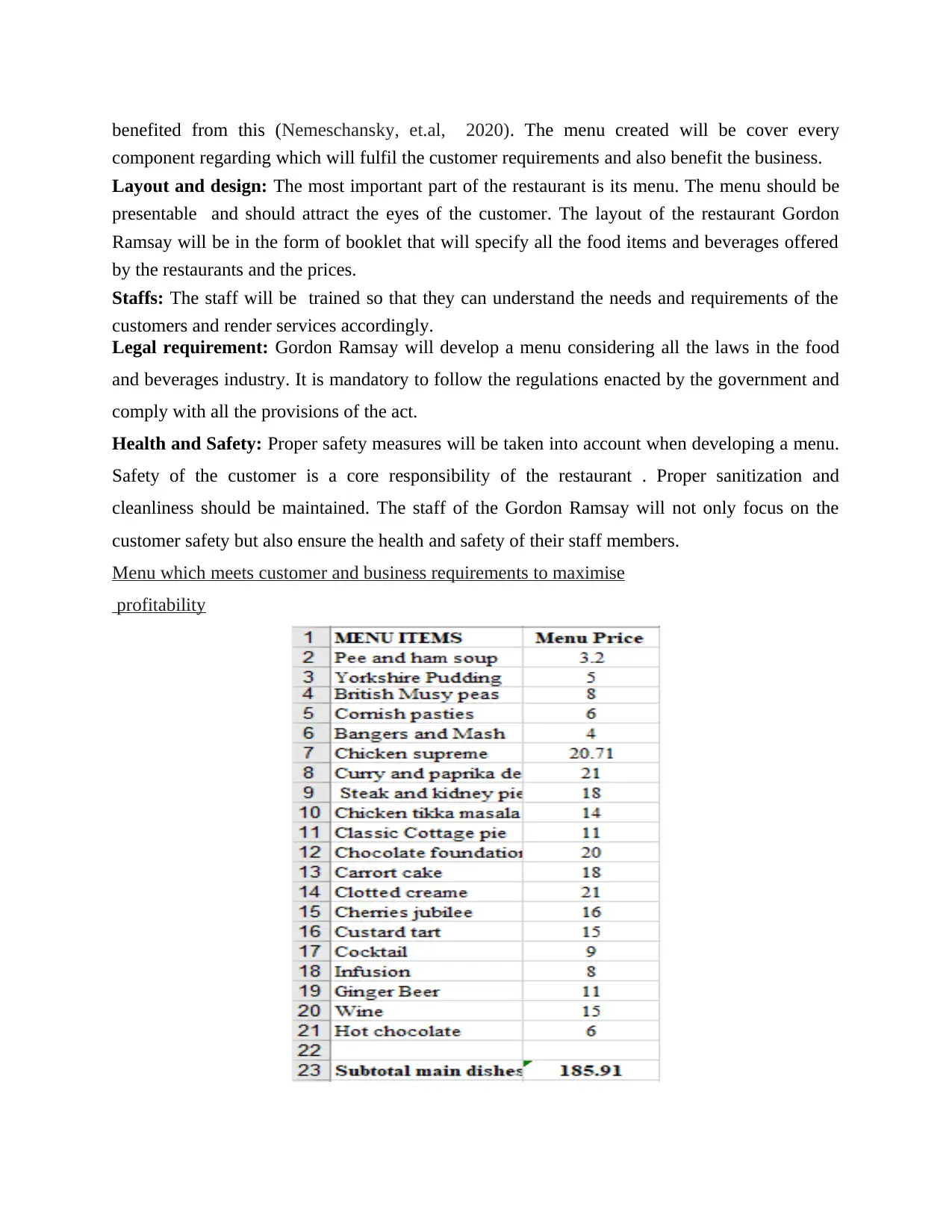
benefited from this (Nemeschansky, et.al, 2020). The menu created will be cover every
component regarding which will fulfil the customer requirements and also benefit the business.
Layout and design: The most important part of the restaurant is its menu. The menu should be
presentable and should attract the eyes of the customer. The layout of the restaurant Gordon
Ramsay will be in the form of booklet that will specify all the food items and beverages offered
by the restaurants and the prices.
Staffs: The staff will be trained so that they can understand the needs and requirements of the
customers and render services accordingly.
Legal requirement: Gordon Ramsay will develop a menu considering all the laws in the food
and beverages industry. It is mandatory to follow the regulations enacted by the government and
comply with all the provisions of the act.
Health and Safety: Proper safety measures will be taken into account when developing a menu.
Safety of the customer is a core responsibility of the restaurant . Proper sanitization and
cleanliness should be maintained. The staff of the Gordon Ramsay will not only focus on the
customer safety but also ensure the health and safety of their staff members.
Menu which meets customer and business requirements to maximise
profitability
component regarding which will fulfil the customer requirements and also benefit the business.
Layout and design: The most important part of the restaurant is its menu. The menu should be
presentable and should attract the eyes of the customer. The layout of the restaurant Gordon
Ramsay will be in the form of booklet that will specify all the food items and beverages offered
by the restaurants and the prices.
Staffs: The staff will be trained so that they can understand the needs and requirements of the
customers and render services accordingly.
Legal requirement: Gordon Ramsay will develop a menu considering all the laws in the food
and beverages industry. It is mandatory to follow the regulations enacted by the government and
comply with all the provisions of the act.
Health and Safety: Proper safety measures will be taken into account when developing a menu.
Safety of the customer is a core responsibility of the restaurant . Proper sanitization and
cleanliness should be maintained. The staff of the Gordon Ramsay will not only focus on the
customer safety but also ensure the health and safety of their staff members.
Menu which meets customer and business requirements to maximise
profitability
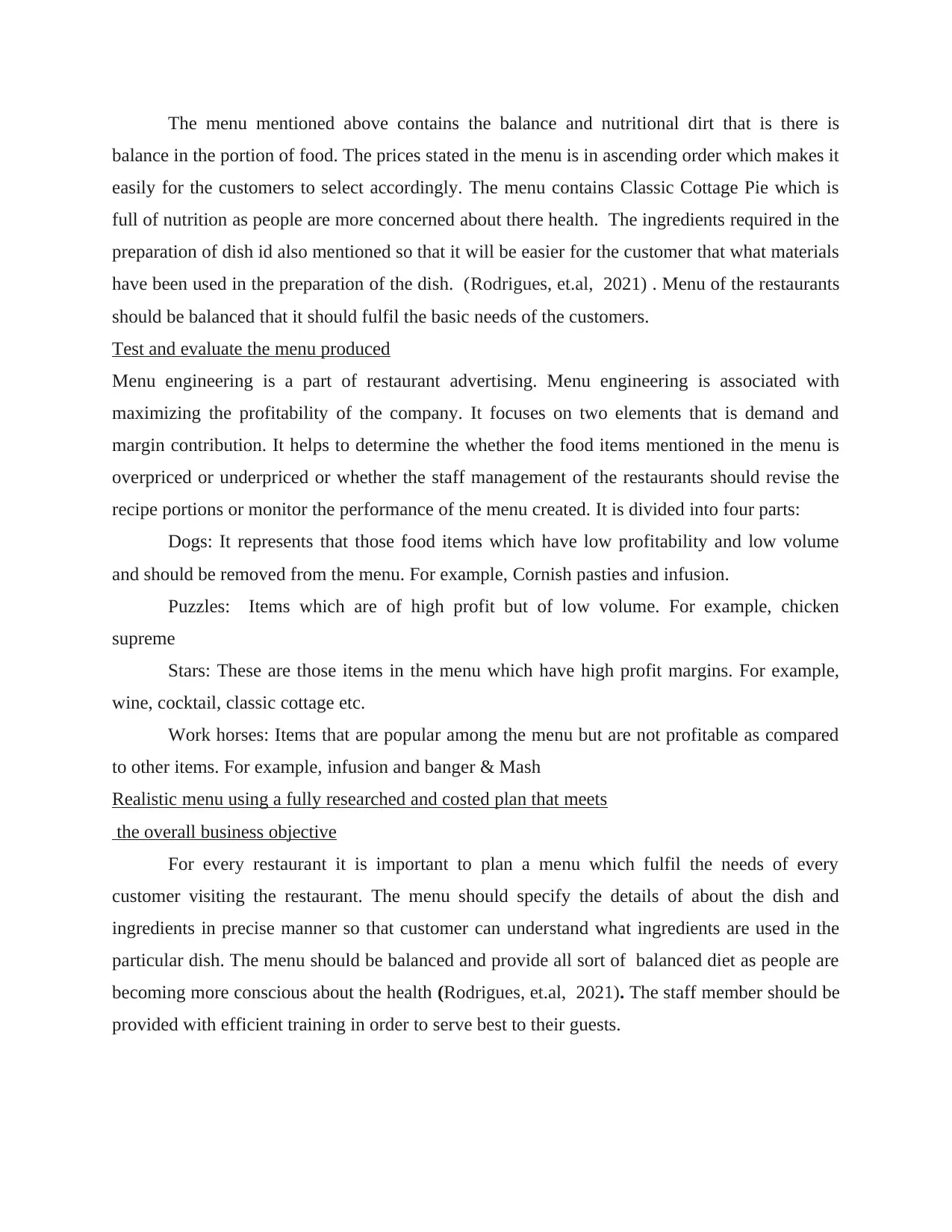
The menu mentioned above contains the balance and nutritional dirt that is there is
balance in the portion of food. The prices stated in the menu is in ascending order which makes it
easily for the customers to select accordingly. The menu contains Classic Cottage Pie which is
full of nutrition as people are more concerned about there health. The ingredients required in the
preparation of dish id also mentioned so that it will be easier for the customer that what materials
have been used in the preparation of the dish. (Rodrigues, et.al, 2021) . Menu of the restaurants
should be balanced that it should fulfil the basic needs of the customers.
Test and evaluate the menu produced
Menu engineering is a part of restaurant advertising. Menu engineering is associated with
maximizing the profitability of the company. It focuses on two elements that is demand and
margin contribution. It helps to determine the whether the food items mentioned in the menu is
overpriced or underpriced or whether the staff management of the restaurants should revise the
recipe portions or monitor the performance of the menu created. It is divided into four parts:
Dogs: It represents that those food items which have low profitability and low volume
and should be removed from the menu. For example, Cornish pasties and infusion.
Puzzles: Items which are of high profit but of low volume. For example, chicken
supreme
Stars: These are those items in the menu which have high profit margins. For example,
wine, cocktail, classic cottage etc.
Work horses: Items that are popular among the menu but are not profitable as compared
to other items. For example, infusion and banger & Mash
Realistic menu using a fully researched and costed plan that meets
the overall business objective
For every restaurant it is important to plan a menu which fulfil the needs of every
customer visiting the restaurant. The menu should specify the details of about the dish and
ingredients in precise manner so that customer can understand what ingredients are used in the
particular dish. The menu should be balanced and provide all sort of balanced diet as people are
becoming more conscious about the health (Rodrigues, et.al, 2021). The staff member should be
provided with efficient training in order to serve best to their guests.
balance in the portion of food. The prices stated in the menu is in ascending order which makes it
easily for the customers to select accordingly. The menu contains Classic Cottage Pie which is
full of nutrition as people are more concerned about there health. The ingredients required in the
preparation of dish id also mentioned so that it will be easier for the customer that what materials
have been used in the preparation of the dish. (Rodrigues, et.al, 2021) . Menu of the restaurants
should be balanced that it should fulfil the basic needs of the customers.
Test and evaluate the menu produced
Menu engineering is a part of restaurant advertising. Menu engineering is associated with
maximizing the profitability of the company. It focuses on two elements that is demand and
margin contribution. It helps to determine the whether the food items mentioned in the menu is
overpriced or underpriced or whether the staff management of the restaurants should revise the
recipe portions or monitor the performance of the menu created. It is divided into four parts:
Dogs: It represents that those food items which have low profitability and low volume
and should be removed from the menu. For example, Cornish pasties and infusion.
Puzzles: Items which are of high profit but of low volume. For example, chicken
supreme
Stars: These are those items in the menu which have high profit margins. For example,
wine, cocktail, classic cottage etc.
Work horses: Items that are popular among the menu but are not profitable as compared
to other items. For example, infusion and banger & Mash
Realistic menu using a fully researched and costed plan that meets
the overall business objective
For every restaurant it is important to plan a menu which fulfil the needs of every
customer visiting the restaurant. The menu should specify the details of about the dish and
ingredients in precise manner so that customer can understand what ingredients are used in the
particular dish. The menu should be balanced and provide all sort of balanced diet as people are
becoming more conscious about the health (Rodrigues, et.al, 2021). The staff member should be
provided with efficient training in order to serve best to their guests.
⊘ This is a preview!⊘
Do you want full access?
Subscribe today to unlock all pages.

Trusted by 1+ million students worldwide
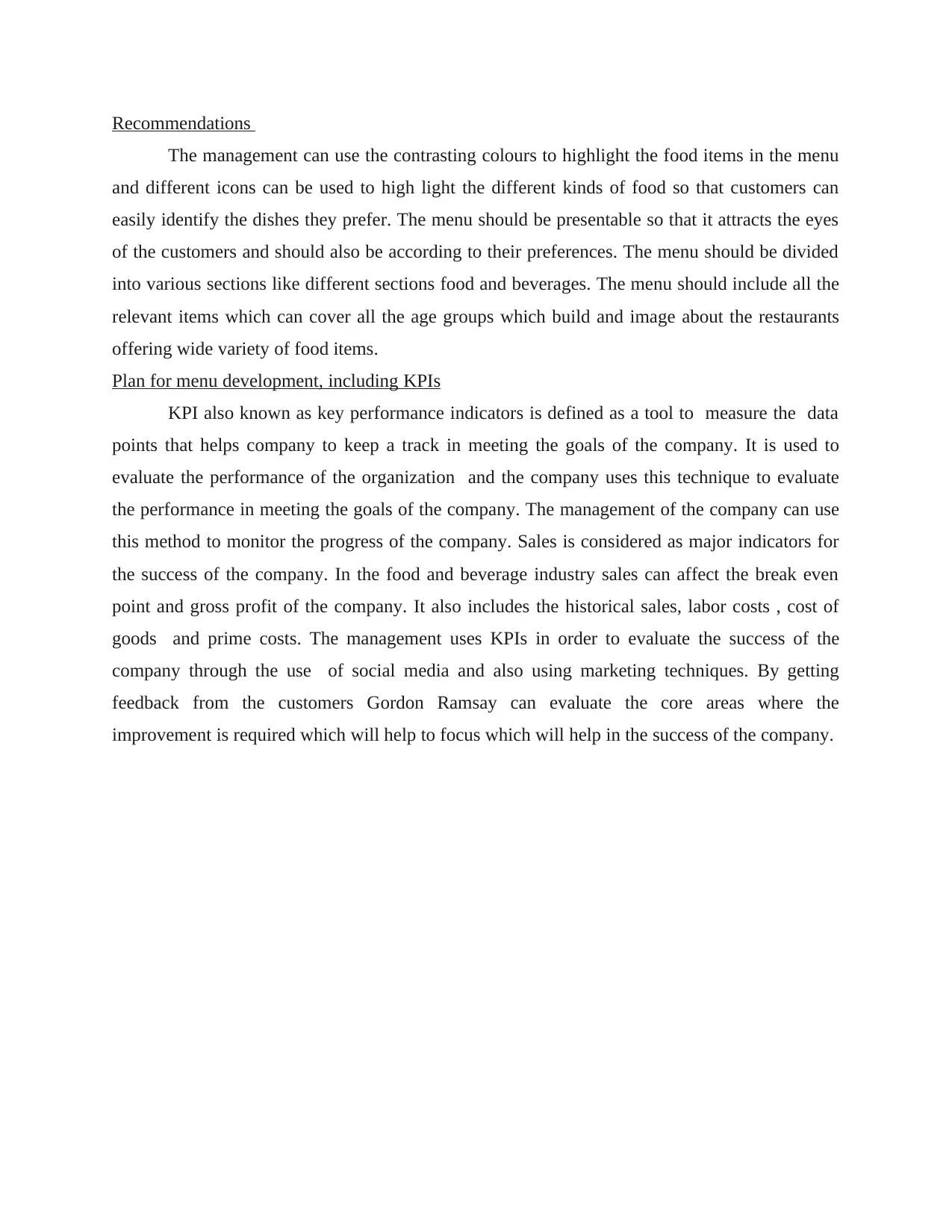
Recommendations
The management can use the contrasting colours to highlight the food items in the menu
and different icons can be used to high light the different kinds of food so that customers can
easily identify the dishes they prefer. The menu should be presentable so that it attracts the eyes
of the customers and should also be according to their preferences. The menu should be divided
into various sections like different sections food and beverages. The menu should include all the
relevant items which can cover all the age groups which build and image about the restaurants
offering wide variety of food items.
Plan for menu development, including KPIs
KPI also known as key performance indicators is defined as a tool to measure the data
points that helps company to keep a track in meeting the goals of the company. It is used to
evaluate the performance of the organization and the company uses this technique to evaluate
the performance in meeting the goals of the company. The management of the company can use
this method to monitor the progress of the company. Sales is considered as major indicators for
the success of the company. In the food and beverage industry sales can affect the break even
point and gross profit of the company. It also includes the historical sales, labor costs , cost of
goods and prime costs. The management uses KPIs in order to evaluate the success of the
company through the use of social media and also using marketing techniques. By getting
feedback from the customers Gordon Ramsay can evaluate the core areas where the
improvement is required which will help to focus which will help in the success of the company.
The management can use the contrasting colours to highlight the food items in the menu
and different icons can be used to high light the different kinds of food so that customers can
easily identify the dishes they prefer. The menu should be presentable so that it attracts the eyes
of the customers and should also be according to their preferences. The menu should be divided
into various sections like different sections food and beverages. The menu should include all the
relevant items which can cover all the age groups which build and image about the restaurants
offering wide variety of food items.
Plan for menu development, including KPIs
KPI also known as key performance indicators is defined as a tool to measure the data
points that helps company to keep a track in meeting the goals of the company. It is used to
evaluate the performance of the organization and the company uses this technique to evaluate
the performance in meeting the goals of the company. The management of the company can use
this method to monitor the progress of the company. Sales is considered as major indicators for
the success of the company. In the food and beverage industry sales can affect the break even
point and gross profit of the company. It also includes the historical sales, labor costs , cost of
goods and prime costs. The management uses KPIs in order to evaluate the success of the
company through the use of social media and also using marketing techniques. By getting
feedback from the customers Gordon Ramsay can evaluate the core areas where the
improvement is required which will help to focus which will help in the success of the company.
Paraphrase This Document
Need a fresh take? Get an instant paraphrase of this document with our AI Paraphraser
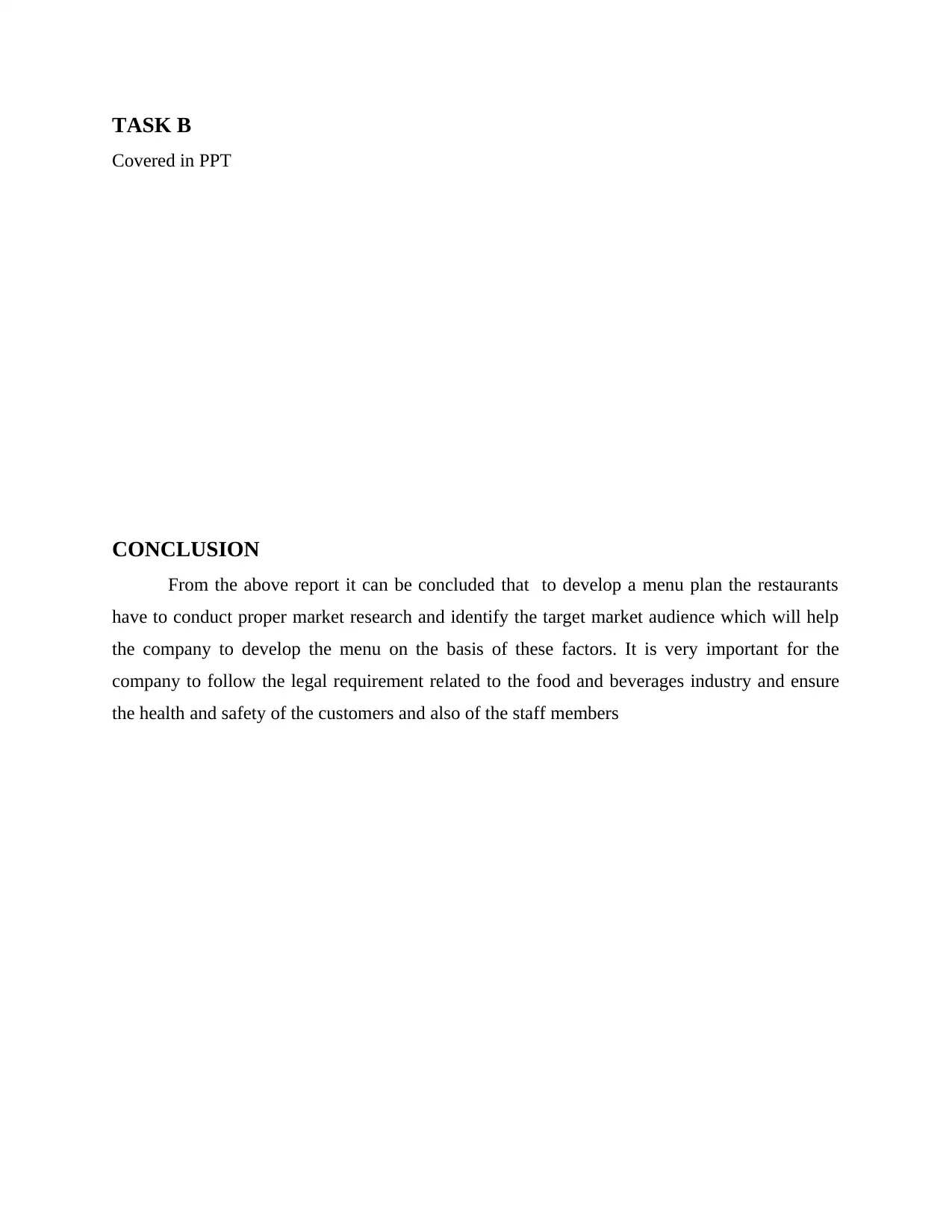
TASK B
Covered in PPT
CONCLUSION
From the above report it can be concluded that to develop a menu plan the restaurants
have to conduct proper market research and identify the target market audience which will help
the company to develop the menu on the basis of these factors. It is very important for the
company to follow the legal requirement related to the food and beverages industry and ensure
the health and safety of the customers and also of the staff members
Covered in PPT
CONCLUSION
From the above report it can be concluded that to develop a menu plan the restaurants
have to conduct proper market research and identify the target market audience which will help
the company to develop the menu on the basis of these factors. It is very important for the
company to follow the legal requirement related to the food and beverages industry and ensure
the health and safety of the customers and also of the staff members
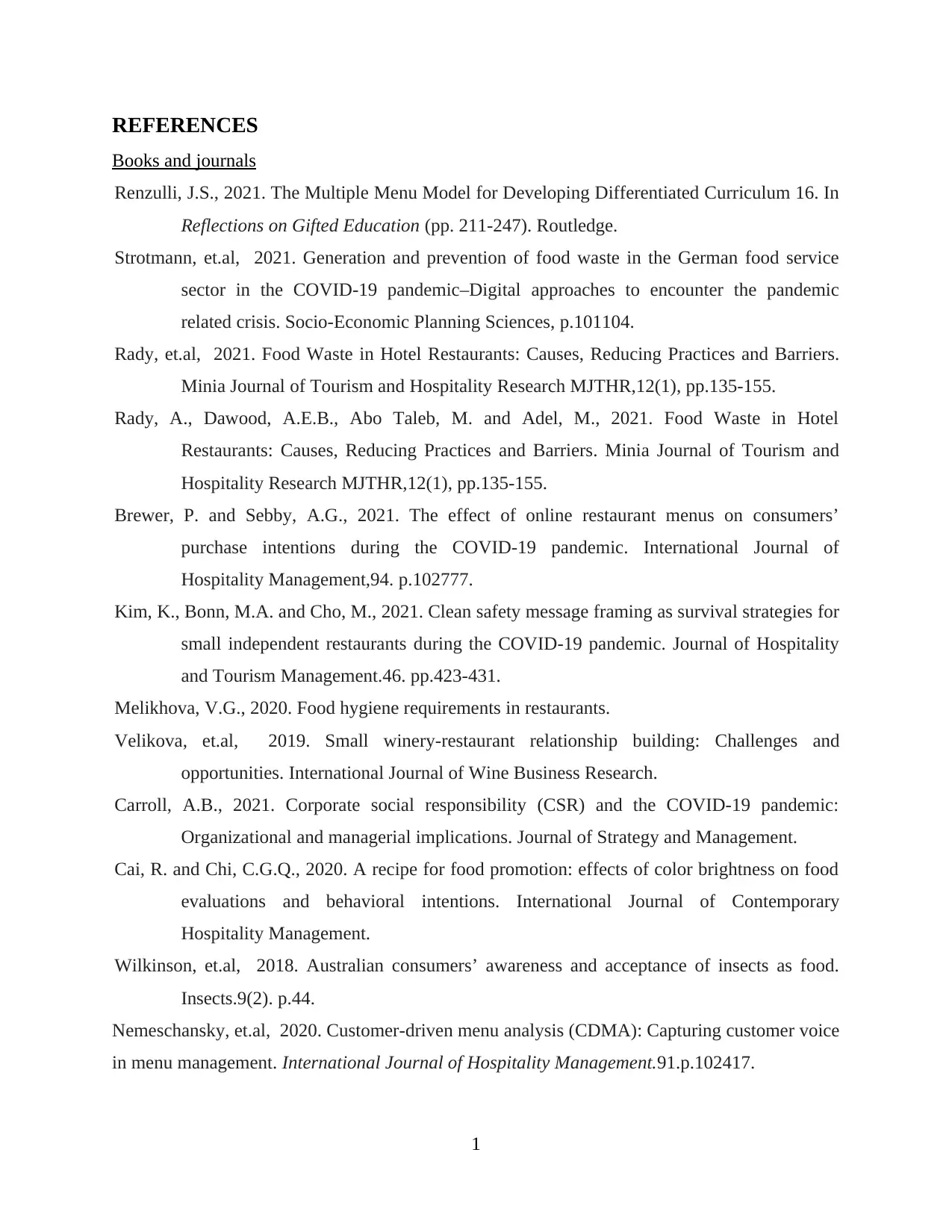
REFERENCES
Books and journals
Renzulli, J.S., 2021. The Multiple Menu Model for Developing Differentiated Curriculum 16. In
Reflections on Gifted Education (pp. 211-247). Routledge.
Strotmann, et.al, 2021. Generation and prevention of food waste in the German food service
sector in the COVID-19 pandemic–Digital approaches to encounter the pandemic
related crisis. Socio-Economic Planning Sciences, p.101104.
Rady, et.al, 2021. Food Waste in Hotel Restaurants: Causes, Reducing Practices and Barriers.
Minia Journal of Tourism and Hospitality Research MJTHR,12(1), pp.135-155.
Rady, A., Dawood, A.E.B., Abo Taleb, M. and Adel, M., 2021. Food Waste in Hotel
Restaurants: Causes, Reducing Practices and Barriers. Minia Journal of Tourism and
Hospitality Research MJTHR,12(1), pp.135-155.
Brewer, P. and Sebby, A.G., 2021. The effect of online restaurant menus on consumers’
purchase intentions during the COVID-19 pandemic. International Journal of
Hospitality Management,94. p.102777.
Kim, K., Bonn, M.A. and Cho, M., 2021. Clean safety message framing as survival strategies for
small independent restaurants during the COVID-19 pandemic. Journal of Hospitality
and Tourism Management.46. pp.423-431.
Melikhova, V.G., 2020. Food hygiene requirements in restaurants.
Velikova, et.al, 2019. Small winery-restaurant relationship building: Challenges and
opportunities. International Journal of Wine Business Research.
Carroll, A.B., 2021. Corporate social responsibility (CSR) and the COVID-19 pandemic:
Organizational and managerial implications. Journal of Strategy and Management.
Cai, R. and Chi, C.G.Q., 2020. A recipe for food promotion: effects of color brightness on food
evaluations and behavioral intentions. International Journal of Contemporary
Hospitality Management.
Wilkinson, et.al, 2018. Australian consumers’ awareness and acceptance of insects as food.
Insects.9(2). p.44.
Nemeschansky, et.al, 2020. Customer-driven menu analysis (CDMA): Capturing customer voice
in menu management. International Journal of Hospitality Management.91.p.102417.
1
Books and journals
Renzulli, J.S., 2021. The Multiple Menu Model for Developing Differentiated Curriculum 16. In
Reflections on Gifted Education (pp. 211-247). Routledge.
Strotmann, et.al, 2021. Generation and prevention of food waste in the German food service
sector in the COVID-19 pandemic–Digital approaches to encounter the pandemic
related crisis. Socio-Economic Planning Sciences, p.101104.
Rady, et.al, 2021. Food Waste in Hotel Restaurants: Causes, Reducing Practices and Barriers.
Minia Journal of Tourism and Hospitality Research MJTHR,12(1), pp.135-155.
Rady, A., Dawood, A.E.B., Abo Taleb, M. and Adel, M., 2021. Food Waste in Hotel
Restaurants: Causes, Reducing Practices and Barriers. Minia Journal of Tourism and
Hospitality Research MJTHR,12(1), pp.135-155.
Brewer, P. and Sebby, A.G., 2021. The effect of online restaurant menus on consumers’
purchase intentions during the COVID-19 pandemic. International Journal of
Hospitality Management,94. p.102777.
Kim, K., Bonn, M.A. and Cho, M., 2021. Clean safety message framing as survival strategies for
small independent restaurants during the COVID-19 pandemic. Journal of Hospitality
and Tourism Management.46. pp.423-431.
Melikhova, V.G., 2020. Food hygiene requirements in restaurants.
Velikova, et.al, 2019. Small winery-restaurant relationship building: Challenges and
opportunities. International Journal of Wine Business Research.
Carroll, A.B., 2021. Corporate social responsibility (CSR) and the COVID-19 pandemic:
Organizational and managerial implications. Journal of Strategy and Management.
Cai, R. and Chi, C.G.Q., 2020. A recipe for food promotion: effects of color brightness on food
evaluations and behavioral intentions. International Journal of Contemporary
Hospitality Management.
Wilkinson, et.al, 2018. Australian consumers’ awareness and acceptance of insects as food.
Insects.9(2). p.44.
Nemeschansky, et.al, 2020. Customer-driven menu analysis (CDMA): Capturing customer voice
in menu management. International Journal of Hospitality Management.91.p.102417.
1
⊘ This is a preview!⊘
Do you want full access?
Subscribe today to unlock all pages.

Trusted by 1+ million students worldwide
1 out of 13
Related Documents
Your All-in-One AI-Powered Toolkit for Academic Success.
+13062052269
info@desklib.com
Available 24*7 on WhatsApp / Email
![[object Object]](/_next/static/media/star-bottom.7253800d.svg)
Unlock your academic potential
Copyright © 2020–2025 A2Z Services. All Rights Reserved. Developed and managed by ZUCOL.



